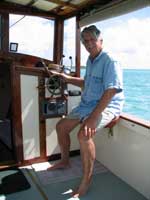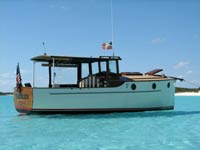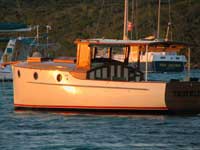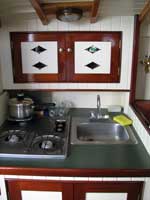| I've been lucky enough to spend the past few winters
cruising the Bahamas in my old 35' Rasmus ketch. When
I tell people this, they get a dreamy look in their
eyes, and you can see they're conjuring up images
of tropical sunsets, warm transparent waters, and
trade winds driving the boat along on a comfortable
reach. And while all of this good stuff does exist,
and you even get to experience it from time to time,
what really brings us back cruising year after year
is the people we meet.
 |
what really
brings us back cruising year after year is the
people we meet. |
Cruisers are this wonderfully self reliant subset
of society. They're out there living their dreams,
and having adventures along the way, so are a pretty
happy bunch. Most of those "adventures"
have to do with torn sails, groundings, docking mishaps,
and gear failures - all pretty entertaining stuff
to recount, over a drink, once you've survived the
episode. But living aboard, you stay busy maintaining
and repairing the boat, trying to avoid too much more
fun of that nature. That's why one popular definition
of cruising is "working on your boat in exotic
locales".
The guys all spend an inordinate amount of time
admiring each others innovations and field repairs.
Anchored off a remote island, far from any marine
services, you get more status points for coming up
with a creative fix, built from materials at hand,
than you do for flying in the proper part from West
marine. And of course, the ultimate statement of self
sufficiency is the home built boat. These are the
guys who are doing it right, because they can fix
everything aboard.
This last March, we were anchored in the lee of
Warderic Wells, waiting out some breezy weather, when
a beautiful little Elco 26 chugged past. I recognized
the design thanks to the Weston Farmer articles in
Messing About. Now this boat
wasn't some tack and tape wonder, coated with house
paint, but one of those museum quality gems you see
on the cover of "Wooden Boat". This was
obviously a home built boat of the highest order,
and I was over the side and in the dinghy, before
they even had their anchor rode cleated. I introduced
myself, admired their vessel, and soon enough was
aboard, getting the tour.
| This boat wasn't
some tack and tape wonder, coated with house paint,
but one of those museum quality gems you see on
the cover of "Wooden Boat". |

|
Her name was "Traveler", very appropriate
in a craft from Yellville, Arkansas ("The Arkansas
Traveler" is a famous American folk song). The
owners were Don and Gayle, and they'd already been
in the islands for 6 weeks, which is a long cruise
on a 26' boat. Traveler was beautiful, but also small,
simple and spartan by modern standards. What was really
impressive was all the stuff they didn't have aboard.
There were no banks of electronics, no portable generator
perched on deck, no television nor stereo system.
And no stainless gantry hanging off the transom, no
solar panels nor forest of antennae. These folks were
simply enjoying being out on the water, with none
of the modern distractions dragged along.
The wind continued to blow, so we wound up dodging
weather with Traveler for the next few weeks, and
learned more of their story. It turns out Don was
a native of the Miami area, and had spent his youth
wandering around Biscayne Bay, in any floating contraption
he could conjure up. Then the happy hippy days of
the sixties and seventies found him anchored off Coconut
Grove, part of the wannabe cruiser feet that flourished
there, before big development decided that boats at
anchor were an eyesore.
Members of this floating community would work menial
jobs for a few months (or years), and spend their
evenings trying to keep their homes afloat. The goal
was to sail off to the islands and have adventures,
if they ever got both their boats and finances shipshape
at the same time. Don was part of this scene for 23
years, and worked a variety of jobs, but eventually
settled in as a carpenter. Gayle came onto the scene
as the cute Blond living on a neighboring boat, without
a dinghy. Gallant Don naturally became her chauffeur.
 |
What was really
impressive was all the stuff they didn't have
aboard. There were no banks of electronics,
no portable generator perched on deck, no television
nor stereo system. |
Don's first floating home was a 35' Cuban fishing
smack, that he bought from early Castro refugees in
1959. He wandered the S.E. coast and the Bahamas in
that $300 boat for 14 years, repairing it as needed,
and eventually adding a cabin over over the aft fish
hold. He also re-rigged her as a schooner. Then he
moved on to a wooden 35' Alden ketch, a bargain due
to her tender condition. Rather than glass her over,
he covered the hull with layers of cedar strips and
epoxy, producing a cold molded skin attached to the
Alden plug. This was his home for more years, until
eventually he got his hands on a fiberglass Hans Christian
33. Finally with a sound craft, he headed across the
Atlantic, visited the Med, and then eventually sailed
her back to Florida, broke again.
Around 1995, Don and Gayle got the bug for some
real estate, and so headed across the country, looking
for cheaper land than Florida offered. An early stop
was in Arkansas, where they wound up buying the first
place they looked at. There they kept busy for several
years, building a house and shop, and then Don's aging
mother moved in with them. They took care of her -
for a long time as it turned out - since she lived
to be 101. Nice genes to have in the family. Happily,
she was in relatively good health, and not that demanding
a guest, so to fill his spare time, Don decided to
build himself a boat.
He wanted a trailerable craft, but something comfortable
enough to live aboard for extended periods. He'd cruised
enough to know that sailing rarely happens when you're
coasting, so he went for the many benefits that a
small power boat can offer. Shoal draft, people shaped
living spaces, and lack of rig to limit bridge passage
are high on that list.
| He'd cruised enough
to know that sailing rarely happens when you're
coasting, so he went for the many benefits that
a small power boat can offer. |

|
Don reviewed a bunch of designs, but didn't quite
see what he wanted in any of the modern plans. In
his inland idle, he had become a Wooden Boat subscriber,
and that had reinforced his preference for classic
boats with traditional lines. And as a carpenter,
he enjoyed a bit of challenging woodwork. So when
Don found some Elco 26 plans on line, they looked
like just what he had in mind.
There followed the usual progression of building
a boat shed, then making the hull. Don was familiar
with cold molding, so rather than the framed construction
in the design, he built a plug of pine. This was covered
with 5 layers of 1/8" cedar strips, glued together
with epoxy. The process was tedious, because at each
layer, he would carefully remove all the thousands
of staples that had held down the cedar below. Finally,
the hull was complete, and after one year, and he
rolled her over to finish her out. That step took
2 more years, as he worked through every detail in
exquisite style.
The plain white hull is set off by a tan deck, with
bright transom and trim. The same color scheme is
carried below. Some cast bronze bits (fairleads, steering
wheel, hinged helmsman stool and ships bell) add the
classic touch. The interior is impossibly large for
a 26 footer, due to the raised deck and plumb sides.
The head is forward in the peak, with a large hatch
above, that allows you to work the ground tackle from
inside the boat. Then the main cabin features settees
port and starboard, and a nice small galley aft. There's
a three burner propane stove and sink with pressure
water to port, and a counter/navigation area to starboard.
Going up 2 steps gets you into the huge cockpit, big
enough to host 10 people, or maybe haul a load of
traps. Most of this area is shaded by the cockpit
roof, with wind and bug screens ready to roll down
and snap fast, if conditions warrant. If Traveler
were my boat, I'd be tempted to enclose most of that
big area, and have a nifty galley and dinette up there,
with a view. The big roof is a perfect spot for solar
panels and/or a dinghy.
 |
The main cabin
features settees port and starboard, and a nice
small galley aft. There's a three burner propane
stove and sink with pressure water to port,
and a counter/navigation area to starboard. |
Don put a 2 cylinder Yanmar diesel in, and burns
about 1/2 gallon an hour, running around 6 1/2 knots.
He has reasonably sized fuel and water tanks, fitted
under the watertight cockpit floor. And even a few
modern conveniences, like depth sounder, vhf , and
refrigeration. There is of course a holding tank forward
for the head.
These old sailors report that the Elco does roll
under way, especially when compared to their sailing
boats. So they have to wait for better weather windows
when contemplating open water passages. Still, the
huge advantages of her shoal draft and trailer ability
make them very happy with the boat. They're set up
to explore the rivers, lakes, and coastal waters the
boat was designed for. And with an adventurous skipper,
Traveler is able enough to cross the gulf stream.
They've spent the last two winters in the Bahamas,
and their plans this summer include an exploration
up the British Columbia coast, perhaps all the way
to Alaska. Wherever they wander, they will be welcome,
traveling in such a gem.
Elco
26 Plans available from Duckworks

Other Articles about Wes Farmer's Designs:
|